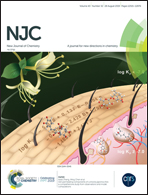A reversible fluoride chemosensor for the development of multi-input molecular logic gates†
Abstract
A potential rhodamine derived chemosensor was synthesized for the quantitative colorimetric detection of F− ions in real-time and to design multiple-input logic gates at the molecular level. Bottom-up fabrication techniques to design logic gates using chemical inputs have been initiated for a decade now and have shown immense promise to make the size of microprocessors even smaller, as the chemical signals are at the molecular level. The chemosensor exhibited a change in color from pale yellow to dark yellow for F− ions. However, upon adding Cu2+ ions the same solution, pink coloration was exhibited. These changes in color and absorbance were used to develop chemical input logic gates. Further, the color change trend could be reversed for sixteen cycles with the alternating addition of F− and Cu2+ ions. Moreover, the chemosensor was used to design combinational three input logic gates by adding Cu2+, F− and Ni2+ ions. In addition, UV-vis titrations and 1H NMR titrations were carried out to understand the color change and binding mechanism. Furthermore, the chemosensor was investigated for its ability to detect F− ions in real samples.



 Please wait while we load your content...
Please wait while we load your content...